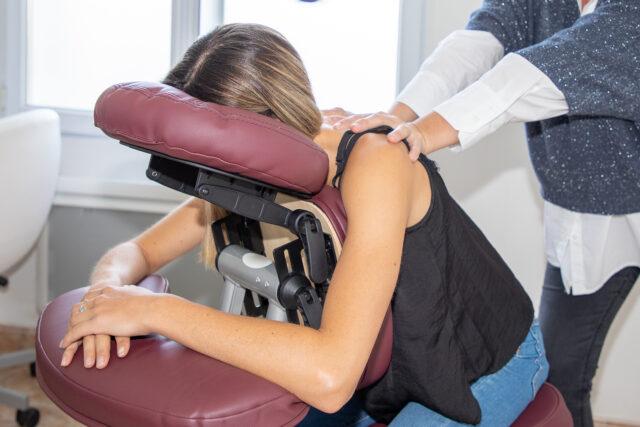 The journey of a massage therapist is one filled with purpose, fulfillment, and the opportunity to make a meaningful difference in the lives of others. For many, it’s not just a job but a calling—an invitation to engage in healing, relaxation, and the overall betterment of people’s physical and mental well-being. But what makes a career in massage therapy so satisfying? What are the elements that contribute to the high levels of job satisfaction that many massage therapists report? In this post, we’ll explore the various facets of this rewarding profession and why so many find it to be a deeply fulfilling career choice.
The journey of a massage therapist is one filled with purpose, fulfillment, and the opportunity to make a meaningful difference in the lives of others. For many, it’s not just a job but a calling—an invitation to engage in healing, relaxation, and the overall betterment of people’s physical and mental well-being. But what makes a career in massage therapy so satisfying? What are the elements that contribute to the high levels of job satisfaction that many massage therapists report? In this post, we’ll explore the various facets of this rewarding profession and why so many find it to be a deeply fulfilling career choice.
1. A Profession Rooted in Helping Others
At the core of massage therapy is the ability to help people. Whether it’s alleviating chronic pain, reducing stress, improving flexibility, or enhancing overall wellness, massage therapists are on the front lines of personal care. They get to witness the immediate and positive effects of their work, which can be incredibly rewarding. This sense of purpose—knowing that your work directly contributes to someone else’s well-being—can be a powerful driver of career satisfaction.
Massage therapists often speak of the profound impact they have on their clients’ lives. Many clients seek massage therapy as a holistic approach to managing chronic conditions, such as back pain, arthritis, or stress-related ailments. The relief they experience after a session can be transformative, both physically and emotionally. For the therapist, this transformation is not just a professional success but a personal fulfillment. Seeing a client leave the session feeling better, moving more freely, or simply wearing a relaxed smile is a daily affirmation of the therapist’s chosen path.
2. A Flexible and Personalized Career Path
One of the major appeals of massage therapy is the flexibility it offers. Massage therapists have the option to work in a variety of settings—from spas, wellness centers, and chiropractic offices to private practice and even mobile massage services. This flexibility extends to work schedules as well. Whether you prefer to work part-time, full-time, or just a few hours a week, you can often tailor your career to fit your lifestyle. For those who value work-life balance, this flexibility is a significant factor in job satisfaction.
Flexibility is particularly important for those who might be balancing multiple responsibilities, such as family, education, or other career interests. The ability to adjust work hours to accommodate personal needs is a key factor in reducing burnout and maintaining long-term satisfaction in the profession. Moreover, this flexibility allows therapists to explore different work environments and client demographics, giving them the freedom to find the niche that best suits their interests and skills.
Additionally, the rise of digital platforms and mobile applications has opened new avenues for massage therapists to offer their services. Mobile massage services, where therapists travel to clients’ homes or workplaces, have become increasingly popular. This not only provides convenience for clients but also allows therapists to expand their client base and work in diverse settings. The ability to create a personalized career path that aligns with individual goals and preferences is a significant advantage of this profession.
3. Opportunities for Specialization and Growth
Massage therapy is a field rich with opportunities for specialization. Therapists can choose to focus on specific modalities such as deep tissue massage, sports massage, prenatal massage, or reflexology. These specializations not only allow therapists to deepen their expertise but also to cater to specific client needs, which can be both financially rewarding and professionally fulfilling.
The pursuit of specialization often leads to a deeper sense of mastery and accomplishment. As therapists gain expertise in a particular modality, they often find themselves sought after by clients who need specialized care. For example, sports massage therapists may work with athletes to prevent injuries and enhance performance, while prenatal massage therapists support pregnant clients through the physical changes of pregnancy. This ability to make a significant difference in specific client populations adds a layer of fulfillment that goes beyond general practice.
Furthermore, the continuous learning aspect of massage therapy contributes to career satisfaction. Many therapists find joy in advancing their skills and knowledge through ongoing education and certification in new techniques. This commitment to growth keeps the career dynamic and interesting, preventing burnout and fostering a sense of accomplishment. Professional organizations like the American Massage Therapy Association (AMTA) and the National Certification Board for Therapeutic Massage & Bodywork (NCBTMB) offer resources for continuing education, helping therapists stay at the forefront of the field.
4. A Positive Work Environment
Unlike many other professions, massage therapy typically takes place in calm, serene environments designed to promote relaxation and healing. The ambiance of a massage therapy room—soft lighting, soothing music, and a general sense of peace—can make for a pleasant work environment. For those who value a tranquil and stress-free workplace, this is an enormous benefit that enhances overall job satisfaction.
The importance of a positive work environment cannot be overstated, especially in a profession where the therapist’s own well-being directly impacts the quality of care provided. A well-designed massage space not only helps clients relax but also contributes to the therapist’s sense of calm and focus. Many therapists find that the peaceful environment of their workspaces helps them maintain a balanced and centered state of mind, which is essential for providing effective therapy.
Moreover, the work environment in massage therapy often fosters a sense of community and connection among colleagues. Whether working in a spa, wellness center, or clinic, therapists often develop strong bonds with their coworkers, sharing knowledge and experiences that enrich their practice. This sense of camaraderie can significantly enhance job satisfaction, making the workplace a source of support and inspiration.
5. Building Strong Client Relationships
Massage therapy is inherently personal. Therapists often develop strong, trusting relationships with their clients. Over time, these relationships can become a source of joy and fulfillment as therapists witness their clients’ progress and improvements in health and well-being. The gratitude and appreciation expressed by clients can be a powerful motivator, reinforcing the therapist’s sense of purpose and satisfaction in their work.
The client-therapist relationship is built on trust, communication, and mutual respect. As therapists work with clients over time, they often become attuned to their clients’ physical and emotional needs, allowing for more personalized and effective care. This deep understanding not only enhances the therapeutic experience for the client but also enriches the therapist’s sense of connection and purpose.
In many cases, these relationships extend beyond the therapy room. Clients often express their gratitude through positive feedback, referrals, and even long-term loyalty. This ongoing relationship provides therapists with a steady stream of clients, contributing to both financial stability and professional fulfillment. The emotional rewards of knowing that your work has a lasting impact on someone’s life are immense and are often cited by therapists as one of the most satisfying aspects of their career.
6. Physical and Emotional Well-Being
It’s not just the clients who benefit from massage therapy—therapists themselves often experience physical and emotional rewards. The nature of the work requires therapists to maintain good physical health, including strength and flexibility. Additionally, the meditative and rhythmic nature of giving a massage can be a calming experience, helping therapists manage their own stress and maintain emotional balance.
Massage therapy is a physically demanding profession, but one that promotes health and wellness. Many therapists find that the physical nature of the job keeps them active and mindful of their own well-being. Regular exercise, proper body mechanics, and self-care practices are essential for sustaining a long and healthy career in massage therapy. This focus on health not only benefits the therapist but also enhances the quality of care provided to clients.
Emotionally, massage therapy can be a deeply rewarding practice. The repetitive, rhythmic movements of massage often create a meditative state for the therapist, allowing them to remain present and focused. This meditative quality can be soothing, helping therapists maintain emotional equilibrium even in the face of life’s stresses. The act of giving a massage can also be a form of emotional release, as therapists channel positive energy into their work, which can be both healing and rejuvenating for themselves.
7. Financial Independence and Career Stability
Massage therapy can offer a level of financial independence and career stability that is appealing to many. With the right business strategies and client base, therapists can build a lucrative practice. Moreover, the demand for skilled massage therapists is steady, contributing to job security. Whether working independently or within an established business, the financial aspect of massage therapy can be a significant contributor to career satisfaction.
The financial potential of a massage therapy career is often influenced by several factors, including location, specialization, and experience. Therapists who establish a strong client base, particularly in areas with high demand for wellness services, can achieve significant financial success. Additionally, those who specialize in high-demand modalities, such as sports massage or medical massage, may command higher rates, further enhancing their earning potential.
Beyond individual practice, massage therapists may also find opportunities in management, education, or product development within the wellness industry. These avenues provide additional career stability and the potential for financial growth. The ability to achieve financial independence while doing work that is personally fulfilling is a powerful motivator for many therapists.
8. The Joy of Continuous Learning and Adaptation
The world of health and wellness is always evolving, and massage therapists who are passionate about their work tend to embrace this evolution. Whether it’s learning new techniques, staying updated on the latest research, or exploring complementary fields like aromatherapy or yoga, the ability to continuously learn and adapt is both a challenge and a source of satisfaction for many therapists.
Continuous learning is a hallmark of the massage therapy profession. As new research emerges and techniques evolve, therapists are encouraged to expand their knowledge and skills. This commitment to lifelong learning not only keeps the practice fresh and engaging but also enhances the quality of care provided to clients. Many therapists find joy in mastering new techniques and integrating them into their practice, offering clients a broader range of services.
Furthermore, the integration of complementary practices, such as aromatherapy, energy work, or yoga, can enrich the therapeutic experience for both therapist and client. By expanding their skill set, therapists can offer a more holistic approach to wellness, addressing the physical, emotional, and spiritual needs of their clients. This holistic perspective is deeply satisfying for many therapists, who see their role as facilitators of overall well-being rather than just physical health.
9. Contribution to a Growing Wellness Movement
In today’s world, there’s a growing awareness of the importance of self-care and holistic wellness. Massage therapists are at the forefront of this movement, providing services that are increasingly recognized as essential to maintaining physical and mental health. Being part of a larger wellness community and contributing to a societal shift towards better health practices can provide a deep sense of pride and satisfaction.
The global wellness movement has brought increased recognition to the role of massage therapy in promoting health and well-being. As more people seek alternatives to conventional medicine, the demand for holistic therapies, including massage, has grown significantly. Massage therapists are now seen as vital contributors to preventive health care, offering services that not only address physical pain but also enhance mental and emotional resilience.
Being part of this broader wellness community can be incredibly fulfilling for massage therapists. The ability to contribute to a societal shift towards healthier living, and to educate clients about the benefits of regular massage, adds a layer of purpose to the profession. Many therapists take pride in being advocates for wellness, knowing that their work is part of a larger movement towards holistic health.
10. Personal Fulfillment and Lifestyle Compatibility
Ultimately, many massage therapists find that their career aligns with their personal values and lifestyle. Whether it’s the desire to help others, the appreciation for holistic health practices, or the need for a career that allows for creativity and personal expression, massage therapy offers a unique blend of professional and personal fulfillment. For those who choose this path, the rewards are often much greater than just a paycheck—they are about living a life in harmony with one’s values and passions.
For many therapists, massage therapy is more than just a job; it’s a way of life. The principles of holistic health, mindfulness, and compassion that guide their work often extend into their personal lives. This alignment between personal values and professional practice is a key factor in the high levels of job satisfaction reported by many therapists. The ability to live a life that is in harmony with one’s beliefs and passions is a rare and valuable gift, and massage therapy offers that opportunity.
Moreover, the creative aspects of massage therapy—such as designing personalized treatment plans or integrating different modalities—allow therapists to express their individuality within their practice. This creative freedom, combined with the ability to make a tangible difference in people’s lives, makes massage therapy a deeply fulfilling career for those who are passionate about health and wellness.
Conclusion: A Fulfilling Path Awaits
For those considering a career in massage therapy, the potential for job satisfaction is immense. From the opportunity to help others to the flexibility and personal growth the career offers, there are numerous reasons why massage therapists find their work fulfilling. It’s a career that not only provides financial stability but also nourishes the soul, offering a unique blend of professional success and personal fulfillment.
Whether you are drawn to the healing aspect, the positive work environment, or the continuous opportunities for learning, massage therapy is a career that offers a deep sense of purpose and satisfaction. If you’re looking for a profession that is as rewarding as it is impactful, massage therapy might just be the perfect fit for you.
—————————————————————————————————————-
Sources:
- American Massage Therapy Association (AMTA). “2023 Massage Profession Research Report.”
- Bureau of Labor Statistics (BLS). “Occupational Outlook Handbook – Massage Therapists.”
- Journal of Bodywork and Movement Therapies. (2019). “Specialization in Massage Therapy.”
- Massage Magazine. “The Role of Work Environment in Massage Therapy Job Satisfaction.”
- International Journal of Therapeutic Massage and Bodywork. (2018). “The Client-Therapist Relationship and Job Satisfaction.”
- Complementary Therapies in Clinical Practice. (2017). “The Meditative Effects of Massage Therapy.”
- Journal of Continuing Education in the Health Professions. (2021). “The Importance of Ongoing Education for Healthcare Professionals.”
- Global Wellness Institute. (2023). “The Wellness Economy: The Role of Massage Therapy.”
- Holistic Nursing Practice. (2020). “Personal Values and Career Satisfaction in Massage Therapy.”

Workplace Massage: Boosting Productivity and Employee Satisfaction
 In today’s fast-paced work environments, employee well-being has become a top priority for organizations aiming to create a positive and productive workplace culture. One increasingly popular method to promote workplace wellness is through massage therapy. In this blog post, we will explore how incorporating massage into the workplace can lead to happier, healthier, and more engaged employees.
In today’s fast-paced work environments, employee well-being has become a top priority for organizations aiming to create a positive and productive workplace culture. One increasingly popular method to promote workplace wellness is through massage therapy. In this blog post, we will explore how incorporating massage into the workplace can lead to happier, healthier, and more engaged employees.
- The Impact of Workplace Stress: Workplace stress is a pervasive issue that can negatively affect employees’ mental and physical well-being. High stress levels lead to decreased productivity, increased absenteeism, and a higher risk of burnout. By offering massage as a workplace wellness program, employers can provide employees with a valuable stress management tool.
- Benefits of Workplace Massage: a. Stress Reduction: Massage helps to alleviate stress by reducing cortisol levels and promoting the release of endorphins, the body’s natural feel-good hormones. Regular massage sessions can help employees manage stress more effectively and maintain a sense of calm and balance throughout the workday. b. Pain Relief: Many employees suffer from musculoskeletal issues and chronic pain due to prolonged sitting, repetitive tasks, or poor posture. Massage therapy can target these specific areas, relieving tension, improving circulation, and reducing pain. c. Improved Focus and Mental Clarity: Massage promotes relaxation and mental clarity, which can enhance cognitive function and concentration. Employees who receive regular massages are more likely to stay focused, make better decisions, and perform at their best. d. Enhanced Mood and Morale: Massage triggers the release of serotonin and dopamine, neurotransmitters associated with happiness and positive mood. By incorporating massage into the workplace, employers can create an atmosphere of well-being, boosting employee morale and job satisfaction.
- Different Approaches to Workplace Massage: a. On-Site Chair Massage: Chair massage is a convenient and efficient option for the workplace. It involves a brief, seated massage that focuses on the neck, shoulders, back, arms, and hands. On-site chair massage sessions typically last between 10 to 30 minutes and can be scheduled during breaks or as part of wellness events. b. Wellness Rooms: Creating dedicated wellness rooms within the workplace provides employees with a quiet, comfortable space where they can receive longer massage sessions or engage in relaxation exercises. These rooms can be equipped with massage tables, relaxing music, and essential oils to enhance the overall experience. c. Wellness Programs and Subsidies: Employers can partner with local massage therapists or wellness centers to offer discounted or subsidized massage sessions for employees. By providing financial incentives or flexible schedules to accommodate massage appointments, employers demonstrate their commitment to employee well-being.
- Implementing a Workplace Massage Program: a. Management Buy-In: To successfully introduce a workplace massage program, it’s crucial to obtain support from management and stakeholders. Highlight the potential benefits, present case studies, and emphasize the positive impact on employee satisfaction, retention, and productivity. b. Partnering with Professionals: Collaborate with licensed and experienced massage therapists or wellness providers who specialize in workplace programs. Ensure they understand the unique needs of office environments and are capable of delivering quality services. c. Communication and Promotion: Proper communication is key to the success of any workplace wellness initiative. Use various channels, such as emails, newsletters, posters, and intranet platforms, to inform employees about the availability and benefits of the massage program. Highlight success stories and encourage employee feedback to create a buzz and generate interest. d. Evaluation and Feedback: Continuously evaluate the effectiveness of the program through employee surveys, feedback sessions, and productivity metrics. Adjust the program as needed based on employee preferences and needs.
Massage therapy is a powerful tool for promoting workplace wellness and improving employee satisfaction and productivity. By addressing stress, reducing pain, enhancing focus, and boosting morale, workplace massage programs have the potential to transform the work environment into a healthier, happier, and more efficient space. Employers who invest in the well-being of their employees through massage initiatives demonstrate their commitment to fostering a positive work culture. By incorporating massage into the workplace, organizations can unlock the full potential of their workforce and reap the long-term benefits of a more engaged and productive team.

Pediatric Massage Therapy for Scoliosis

Scoliosis is a condition that millions of Americans are familiar with. You may have already worked with patients who suffer from pain, discomfort, and stiffness due to scoliosis. This condition is particularly detrimental to children, who may struggle with weak muscles, back pain, and fatigue from long periods of standing upright.
Luckily, massage therapy can be used to help treat scoliosis in children. A pediatric massage involves manipulating soft tissues with the aim of relieving tension and improving blood flow to affected regions. When done correctly, the symptoms of scoliosis in children can be significantly reduced.
Understanding Scoliosis in children
Scoliosis is a condition where the spinal cord curvature is increased more than usual. The spine typically has a mild curve as it runs across your back. However, patients with scoliosis have a spinal cord that resembles a C or an S shape.
Congenital scoliosis (in children) typically occurs during birth and affects children as they continue to grow. The severity of this condition will vary from one patient to another. Some spinal curvatures are barely noticeable, while others can even cause a deformity in the spine.
Some risk factors of scoliosis include birth defects, infections, cerebral palsy, or genetic disorders such as Down Syndrome. Adding pediatric massage therapy skills to your current knowledge base will help you provide adequate relief to scoliosis patients.
Symptoms of Scoliosis
Scoliosis in children manifests itself in many different ways. It can begin to develop in the womb due to the incorrect division of vertebrae, or vertebrae that don’t fully grow during early stages. Diagnosis may be done soon after birth- or even later on when the child is 10-15 years old.
Some of the most common symptoms include:
Chronic back pain
An incorrectly tilted spine and pelvis
Fatigue from standing upright
Uneven shoulders
Benefits of Massage therapy
Pediatric massage therapy is a useful technique that can treat scoliosis in children. For example, effleurage massage techniques target the soft tissues and warm them up for adjustment. Through repeated strokes along the length of a child’s spinal cord, the muscles can relax and ease pain, stiffness, or tension.
Massage therapy also uses a combination of lubricants to soften the muscles and increase blood circulation to affected areas. Children with scoliosis can enjoy significant relief from symptoms and live a healthy life with timely massage therapy sessions.
Massage therapy techniques you can learn in massage school
If you wish to advance your knowledge and skills in massage therapy for scoliosis, attending massage school is an excellent way to get started. With these advanced skills under your belt, you’ll be able to provide timely pediatric massage therapy to children who’ve been affected by this condition.

Massage Therapy Job Outlook in Washington
 Massage Therapy Job Outlook – A career in massage therapy gives you the power to relieve pain and promote health while earning a good income. Nationally, the field is expected to continue growing at an accelerate rate through the year 2024.
Massage Therapy Job Outlook – A career in massage therapy gives you the power to relieve pain and promote health while earning a good income. Nationally, the field is expected to continue growing at an accelerate rate through the year 2024.
For massage therapy Seattle and its tech-heavy culture make a perfect match. If you are thinking about a career in massage therapy Seattle is one of the best places in the country.
Washington State Requirements
Massage therapists are regulated by the Washington State Department of Health, Board of Massage. To maintain an active license, therapists must meet the following requirements.
Applicants must complete an approved training program that includes:
- 130 hours anatomy and physiology
- 40 hours kinesiology instruction
- 50 hours pathology
- 265 hours theory and practice, including technique
- 55 hours clinical and business practices
- Red Cross first aid certification
- CPR certification
- 4 hours HIV/AIDS discussion
Those who received training out-of-state or who are licensed in another location may not meet Washington state education requirements. To verify previous experience, a verification form must be completed by the jurisdiction or school where your credentials were gained.
All applicants must successfully complete the National Certification Board for Therapeutic Massage and Bodywork (NCBTMB) or Federation of State Massage Therapy Boards (FSMTB) examination.
After completing the training program and testing, therapists must submit all necessary paperwork to the Board of Massage, along with any applicable fees. Once your application information is verified, you will receive your Washington state massage therapy license.
Massage therapy licenses expire on the holder’s birthday every year. They can be renewed up to 90 days in advance.
Every two years, practitioners must complete 24 hours of continuing education credits. These must include:
- 8+ hours direct massage skills training
- 4+ hours professional ethics, communication, or review of state laws and regulations
- 2 hours review of professional roles and boundaries
Massage Therapy Seattle Area Employment Outlook
For those practicing massage therapy Seattle has a variety of job opportunities in different industries.
- Personal care services, such as in-home aid
- Working with other health practitioners as part of a team
- Amusement and recreation, such as spas and high-end hotels
- Hospitals and long-term rehabilitation care
Massage Therapy Job Outlook for Washington is great in general. For a successful career in massage therapy Seattle is a great place to set up a freelance operation. For mobile massage therapy Seattle is the perfect place to create your own career by making office visits.
- When it comes to pay for those practicing massage therapy Seattle is one of the best paying locations in the country. Seattle area therapists command an impressive hourly mean wage of $26.89, well above the national average of $19.17.
- Washington has the 4th highest demand for massage therapists in the country. The state also consistently posts high employment rates for those in the field.
- Massage therapy positions in Washington are expected to increase by 41.3% in the next 8 years. The demand for new massage talent will soon cause a shortage of qualified applicants. This could drive wages up in the future, making the area even more attractive for knowledgeable bodywork professionals.
When practicing massage therapy Seattle offers opportunity and variety. Enjoy a fulfilling and profitable career as a respected health professional. When it comes to massage therapy Seattle is the best place in the country to learn, practice, and live.
For questions relating to the Massage Therapy Job Outlook in Washington State contact our admission department today!





